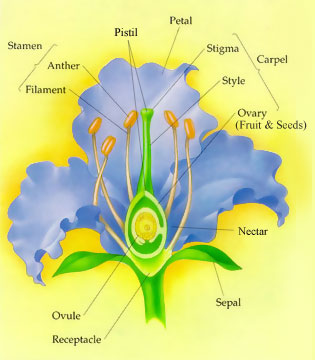Pollination
How pollination works?

Pollination is the act of moving pollen from the anthers of a flower to the stigma, allowing the flower to develop seeds for reproduction. The stigma is the receptive surface of the pistil. Pollen tubes grow down through the pistil to the plant's ovules. The sperm migrate through these tubes to fertilize the ovules. Fertilization is necessary for production of viable seeds and the fruits which surround those seeds.
Some flowers can self-pollinate when pollen from their own anthers falls on the stigma. However, many plants require help from elsewhere to move the pollen. Wind moves the pollen for some plants such as grasses like corn. Animal pollinators move pollen for many other flowering plants.
Plants must be pollinated so they can make seeds. Without pollen from a different plant of the same kind, the plant cannot reproduce (make seeds).
The pollinators

Pollinators move pollen from the anthers to the stigmas of flowers, thus effecting pollination.
Insects and animals that are known to be good pollinators of flowers include bees, butterflies, hummingbirds, moths, some flies, some wasps, and nectar feeding bats.
They visit flowers to eat pollen, nectar, and other smaller insects, and as they visit other flowers in bloom they inadvertently pollinate them. Even though this pollination seems accidental, both insect and plant benefit.
The benefits
Plants benefit from pollinators because the movement of pollen allows them to reproduce by setting seeds. However, pollinators don't know or care that the plant benefits. They pollinate to get nectar and/or pollen from flowers to meet their energy requirements and to produce their own offspring. In the economy of nature, the pollinators provide an important service to flowering plants, while the plants pay with food for the pollinators and their offspring.